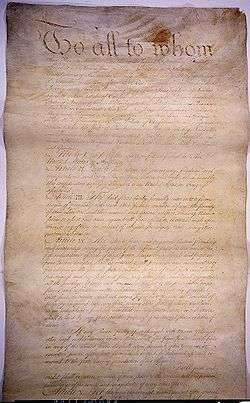John Collins (Continental Congress)
John Collins (June 8, 1717[1] – March 4, 1795), was the third Governor of the U.S. state of Rhode Island from 1786 to 1790. He was the last Independent to serve as Governor of Rhode Island until Lincoln Chafee (2011–2015).
American Revolution
Born in Newport, he was the son of Samuel and Elizabeth Collins. He stood forth as a staunch advocate of the independence of the Thirteen Colonies. An admirer of George Washington, he was selected by the governor of Rhode Island in 1776 to carry a letter to Washington informing him of the condition of the colony and soliciting counsel upon the best method to adopt for its defense. Later (1782) he was made bearer to the President of Congress of a statement of Rhode Island's reasons for rejecting the Impost Act. During the American Revolution, Rhode Island was for the most part an agricultural area and as such opposed the restrictions of a national government.
In 1778, Collins represented Rhode Island in the Second Continental Congress, where he served until May 1781, when he was superseded by William Ellery. He was, however, re-elected in 1782 and held the position until 1783.
Post Revolution
Within the state the agricultural interests vigorously advocated a paper currency. Collins espoused their cause and in 1786 was elected governor. During his term in office the issuance of paper money, which had been ceased at intervals since 1750, was resumed. It was provided by law that should any creditor refuse to accept the bills of the state the debtor might secure a discharge by depositing the amount of his debt with one of the judges of the state superior court or the court of common pleas. This law led to the suit of Trevett vs. Weeden, which resulted in a decision looking toward the right of courts to declare legislative enactments unconstitutional.[2]
In 1786 Collins was elected governor of Rhode Island and took office on May 3, 1786.
Rhode Island's ratification of the U.S. Constitution
When George Washington was inaugurated as President on April 30, 1789 Rhode Island was one of only two of the thirteen original states (along with North Carolina) not to have ratified the United States Constitution and was, technically speaking, an independent nation with Collins as it chief of state.
Anti-Federalist elements in Rhode Island, up to 1790, vigorously fought against the calling of a convention to decide upon entering the Federal Union, but in that year (January 17) gave its sanction to such a call by a majority of one vote in the General Assembly. This vote was cast by Collins, who had come to realize the importance of a Federal connection. The vote cost him his popularity and the governorship. He left office on May 5, 1790. The Rhode Island General Assembly ratified the United States Constitution on May 29.
Later in 1790 Collins was elected to the 1st Congress but did not take his seat.
Personal life
Collins was married to Mary, daughter of John Avery of Boston, and his daughter Abigail married John Warren. Collins died at Newport was buried on his farm,[3] "Brenton Neck", near Brenton Point in that city.
His grandson and namesake, John Collins Covell (1823–1887), was a principal of the Virginia School for the Deaf and the Blind and West Virginia Schools for the Deaf and Blind.
The Rhode Island Society of the Sons of the Revolution holds an annual observance of Rhode Island Independence Day (May 4) at Governor Collins' grave.
Notes
- ↑ CBD gives June 8; DAB, November 1.
- ↑ Richman, I. B., Rhode Island, A Study in Separatism, 1905, pp. 78–81.
- ↑ John Collins at Find a Grave
References
- "John Collins". Dictionary of American Biography. American Council of Learned Societies, 1928–1936.
External links
| Political offices | ||
|---|---|---|
| Preceded by William Greene |
Governor of Rhode Island 1786–1790 |
Succeeded by Arthur Fenner |
| ||||||||
|

